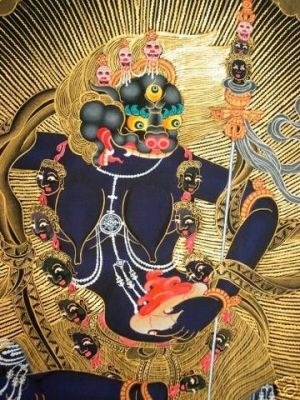Simhamukha or Senge Dongma (Sanskrit:Siṃhamukhā)
Simhamukha or Senge Dongma (Sanskrit:Siṃhamukhā; Tibetan:sen-ge’i gdong ma or senge-dong-chen) can be translated into English as Lion-Faced Dakini.
According to the Indian traditions followed by the Sarma schools, the dakini Simhamukha is a tutelary deity arising out of the Chakrasamvara cycle of Tantras and belongs to the Anuttarayoga 'wisdom'
classification. The Sarma schools' Simhamukha is unrelated to the deity of the same name and appearance which arose in the later indigenous Tibetan Nyingma 'terma' (treasure) traditions, where she is regarded as the secret form of Guru Rinpoche (Padmasambhava).
According to the Nyingma school, this dakini and female tantric Buddha is the principal
dakini teacher and one of the principal fierce manifestations of Padmasambhava, the 8th Century mahasiddha, claimed to be the founder of the same school.
As such, she is connected with many ceremonies of the Dzogchen tradition. A fierce dakini, she is also one of the Phramenma,[1] a group of female deities from the Bardo Thödol, or 'Tibetan Book of the Dead'.
The female lama Jetsun Lochen (1865- 1951) founded a Simhamukha practice lineage.[2]
RIGPA SHEDRA names him Senge Dradok describing him to be one of the eight principal forms assumed by Guru Rinpoche at different points in his life, Senge Dradok's activity being "the subjugation of non-buddhists".[3] Referring to "A Great Treasure of Blessings", page 30, it is said: Guru Rinpoche
challenged and defeated five hundred upholders of wrong views in debate at Bodhgaya. He reversed their magic with the aid of a wrathful mantra given him by the lion-faced dakini Marajita. ,[4]
Simhamukha is iconographically represented as a wrathful deity who is usually depicted as a dark blue, or maroon, coloured lion-faced female and is associated with the direction East. As Simhavaktra, an alternate form of Simhamukha, she is also an attendant of the Dharmapala Palden Lhamo, in which case she is depicted as carrying both a kapala, or skullcup, and a kartika, or ritual knife.
According to Khandro.net Sengdongma (lion-faced dakini) is a wrathful manifestation of Padmasambhava [[[Guru Rinpoche]]] who eliminates obstacles, whereas Sinhavaktra is a dark blue Lion-head Dakini who dispels obstacles to enlightenment. She holds a broad-bladed knife and skull cup.[5]
Hindu legend
Every Hindu temple has the face of lion at the apex entrance carved artistically. This lion-face appears at the top of the door, niche, and windows as well. The countenances of man and lion are fused and it is also known as Simhamuka or Simhalalata. It is supposed to lead worshippers to Supreme Reality.
Simhamukha usually indicates Rahu (eclipse). One of the nine planets, Rahu stands for a devourer.
There is a Puranic story
During the fight between gods and demons for nectar or Amrita, the demon Rahu tried to get a sip of drink of immortality, stealthily. But he was caught in the nick of time by the Surya (the Sun God) and Chandra (the
Moon God) and Lord Vishnu was informed instantly. He cut off Rahu's head. But the head became immortal, having tasted a drop of nectar. Rahu now tried to swallow Sun and Moon when they passed near him. During eclipses (grahana), this scene is repeated according to believers.
Rahu is the son of Simhika or the lioness, who symbolizes destruction. The incarnation of Narasimha has this concept behind it. The earliest carving of Kirtimuka or Simhamukha is seen in the stupa at Amaravati (2nd century C.E.). Dancers of Cambodia use Kirtimuka as a headdress. Artifacts and any worship-worthy idols or mandaps carry this symbol.
Tibet
Within the Nyingma School, of the two divisions of Kama (Oral Teachings) and Terma (Revealed Treasures), Simhamukha belongs to the Terma. From the three general divisions of Terma: Root, Branch and Essence, Simhamukha belongs to the
Dakini Cycle within the Root Terma class. Only in the Nyingma tradition she is regarded as the secret form of Guru Rinpoche Padmasambhava. Otherwise, in the Sarma Traditions coming from India, the deity Simhamukha is found in the Chakrasamvara Cycle of Tantras. Although both forms are similar in name and appearance, they are unrelated.
The dakini Simhamukha is a tutelary deity arising out of the Chakrasamvara cycle of Tantras and belongs to the Anuttarayoga 'wisdom' classification. The Sarma tradition Simhamukha is unrelated to the deity of the same name and appearance in the Nyingma 'terma' (treasure) traditions. In that tradition, of the many forms of Padmasambhava, Simhamukha is a secret form of Guru Rinpoche.
Gelugpa lineage: Vajradhara, Dakini Simhamukha, Vajrasana, Bari Lotsawa Rinchen Drag, Sachen Kunga Nyingpo (1092-1158) and the five Holy Superiors of Sakya, Rongpa Dorje Gyaltsen, Sanggye Yeshe, Yak De Panchen, Gyalwa Tsongkapa (1357-1419), etc.
There is reference to this protector's emanations in the Shurangama Mantra found in the Tibetan Chandragomin's Shurangama Mantra Sadhana translated from the original Buddhist Hybrid Sanskrit into Tibetan (Tibetan canon Tengyur Karchag Phangthangma Toh 3096, Toh 593/2/1), and also Padmankusha's
Text Toh 3106, and the Vajrasana's Text Toh 3110 - Sarvatathāgataoṣṇīṣaśitātapatrā-nāmāparājitā-mahāpratyangirā-mahāvidyārājñī-nāma-dhāraṇī; Tibetan name is 'phags pa De bshin gshegs pa'i gtsug tor nas byung ba'i gdugs dkar po can gshan gyi mi thub pa phir bzlog pa chen mo mchog tu grub pa shes bya ba'i gzungs.
References and footnotes
see Glossary of Terms - T Tramenma (phra men)
Shaw, Miranda (1994). Passionate Enlightenment::Women in Tantric Buddhism. New Jersey: Princeton University Press. p. 227. ISBN 0-691-01090-0. Eight Manifestations of Guru Rinpoche @RigpaShedra
Sengé Dradrok (Wyl. seng ge sgra sgrogs; Eng. 'The Lion's Roar') RIGPASHEDRA [1]
Reynolds, John Myrdhin. Simhamukha: Wrathful Lion-Headed Dakini
Shaw, Miranda (1994). Passionate Enlightenment::Women in Tantric Buddhism. New Jersey: Princeton University Press. p. 27. ISBN 0-691-01090-0. see Tibetan Buddhist Center Ati Ling Chagdud Gonpa Bay Area, California LION-FACED DAKINI
Literature
Beer, Robert, Simhamukha Senge Dongma, Wisdom Books, Publisher Robert Beer, 1996
